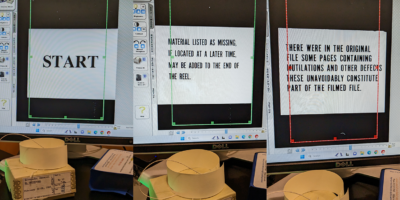By Leah Anderst
The Spring 2017 semester was not the first time I created a blogging assignment for one of my classes. I used a blog for a previous iteration of this same documentary film class at QCC, and I’ve used them regularly in classes I taught elsewhere. Here’s one from a technology focused writing class at Marymount Manhattan College, and here’s another from a children’s lit class at St. Johns University. I judged these prior attempts as basically successful: my students were engaging with each other more regularly than just during class time, and the blogging format allowed them a chance to write in a voice that’s somewhere between informal, response-type writing and formal, graded writing assignments. The CUNY Academic Commons site that I created for my documentary film class this spring, with the support of a CAC Faculty Fellowship, replicated the successful aspects I wanted to continue from my past blogging experiences, but it also provided me and my students with a few important things that were lacking in my past sites.
The first and most important is the CUNY-hosted nature of the platform. It may seem like a minor detail, but where you host a blog that’s connected to a course is actually quite important. All of the past blogs that I linked to above are on blogger.com/blogspot.com—sites now owned by Google. I chose that platform over, say, the group messaging functions on Blackboard because I felt that creating a more customized site would make it more interesting to students, and they’d have a more public audience than in Blackboard. I did have qualms, though, about directing my students to a commercial platform where they’d have to create an account in order to become authors (yet another login/password to for them to remember!), and where their course writing would essentially become the property of a company. So, the Commons has the distinct benefit of allowing members of the CUNY community to create customized sites while keeping them within the CUNY universe.
And for my students, this entry into the wider universe of CUNY was one of my chief objectives. My five years at QCC have shown me that a large portion of the students there tend to be somewhat cut off from the college itself and from the larger university. Community college students have multiple obligations outside of school, and they tend not to participate in extracurricular activities as much as students in senior colleges. I hoped that being able to access “CUNY” online in a way that felt dynamic would help connect them to a community. My past blogs may have done this in a small way—connecting them more to their peers in the class—but my hope with this class was that working on the Commons would provide them an additional way “in” to the larger university structure. In short, I hoped that the Commons page would provide my students with at least an indirect awareness of all that CUNY has to offer them.
It’s hard to know whether the page accomplished that goal. On the second meeting of the semester, I had the students create Commons login credentials and join our course page. (Pro tip: being scheduled in a computer lab really helps if you’re considering running a Commons page for your course. This is especially true for our community college students, many of whom may not have computers at home.) That second course meeting we spent some time together browsing other pages on the Commons: pages for courses at other colleges, personal pages made and maintained by individual CUNY students or faculty members, and various interest groups that they could decide to join or follow. I gave them time that day to browse the Commons on their own as well, and I walked around the room as they explored and discussed pages. They seemed interested and curious about much of what was available to them there. Whether they continued to do this outside of the classroom, and whether this really gave them the larger sense of CUNY, I can’t know in a measurable way, but I do think it helped expand their thinking about the communities they have access to as CUNY students.
The Commons site offered two other benefits that are essentially technical, but quite important nonetheless. I was able to choose a setting on the page so that all blog members would be notified by email each time someone published a new post or commented on an existing post. This meant that we wouldn’t have to check the page randomly to see if there was any new activity, and it meant that the habits of those early bird students who finish their assignments in a timely way would be visible to everyone in the class. My sense is that this had an important impact on keeping less focused students on track.
Another feature of the site that I added with the help of Laurie Hurson, one of our Fellowship advisors, was a plugin that allowed me to see summaries of the blogging activities of all my students. I give students credit for their posts and their comments, and in my past experiences, it has been labor-intensive to keep track of who posted what when. One semester, I spent many hours scrolling and scrolling through posts and comments to be sure I had accounted for each and every entry and hadn’t shorted any of my students in their grade. On my Commons page, on the other hand, the user summaries made it very easy to find that information quickly. At the semester’s end, it took me about a half hour to check my records against the blog itself.
In short: consistently engaged students + CUNY platform + efficient grading = one highly satisfied instructor!
Leah Anderst is an Assistant Professor of English at Queensborough Community College.









Leave a Reply